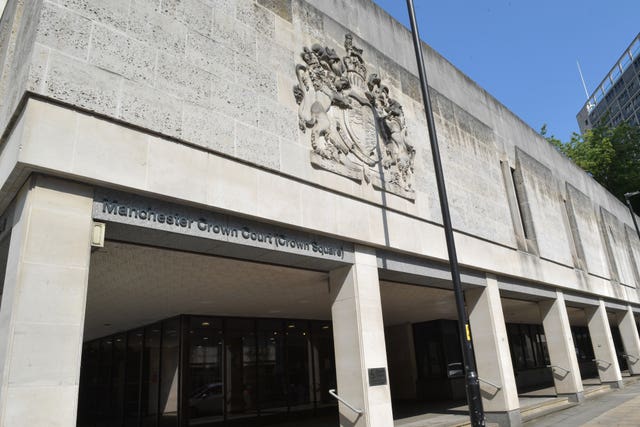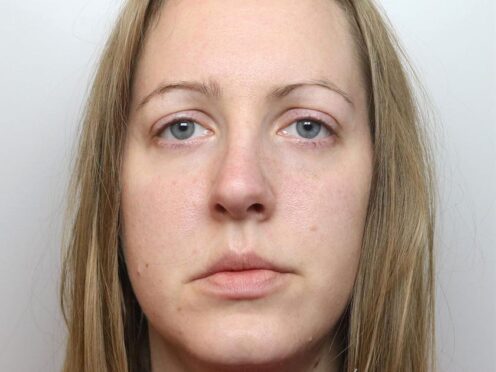A senior doctor has told a jury he saw “no evidence” of nurse Lucy Letby having done anything to help a deteriorating baby girl before he walked into an intensive care room.
Letby, 34, is on trial at Manchester Crown Court accused of deliberately displacing the youngster’s breathing tube while she worked on a night-shift at the Countess of Chester Hospital’s neo-natal unit.
Less than two hours earlier, the baby – known as Child K – was born extremely premature at 2.12am on February 17 2016, weighing 1lb 8oz (692g).
The prosecution say consultant paediatrician Dr Ravi Jayaram caught the defendant “virtually red-handed” as he entered the unit’s intensive care room and saw Letby standing next to Child K’s incubator and “doing nothing”.
The jury of six men and six women has been told that Letby was convicted at a trial last year of the murders of seven babies and the attempted murders of six other infants at the Countess of Chester between June 2015 and June 2016.
Giving evidence on Thursday, Dr Jayaram said he was sat at a desk at the nurses’ station near to the intensive care room on February 17 when Child K’s designated nurse told him she was heading to the labour suite to speak to Child K’s parents and Letby would cover for her.
He told the court: “At this time, we had had a number of unusual incidents with babies, and a number of colleagues and myself had noted the association with Lucy Letby being present at these things.
“We had had a thematic external review which had not found any other obvious factors.
“I will be honest, I felt very uncomfortable. Objectively, you can say that was completely irrational. I just had a feeling, knowing what had happened before.
“My internal dialogue was very much ‘stop being stupid, get on with your work’ but I just needed to go in and reassure myself that everything was OK.

“I stood up and walked in. I saw on the screens that (Child K’s) oxygen saturations were dropping. They were in the low 80s and going downwards.
“Lucy Letby was stood next to the incubator. She wasn’t looking at me. She didn’t have her hands in the incubator. She was definitely facing in my direction.
“As I approached, I said ‘what’s happened?’ and Lucy looked up and said ‘it looks like she is desaturating’.”
Alarms were supposed to sound if blood oxygen levels dipped below 90% but he did not hear any, the doctor said.
He went on: “I didn’t look to see whether the button that can cause the alarm to be suspended was pressed but the saturations were going down and continued to go down.
“There was no alarm and had an alarm gone off, that would have been my prompt to go in. The alarms are loud. If an alarm had gone off, I would have heard it.”
Prosecutor Nick Johnson KC asked: “Did you look at (Child K) yourself?”
He replied: “Yes, the important thing is not to treat numbers on the screen. What I saw was whereas previously her chest had been moving up and down, her chest was not moving very well.
“I took a stethoscope and had a listen to both sides. Previously, I could hear air going in and out. There was very poor air entry so there was a change in the sound of her breaths.”
He said he quickly went through a series of checks to try and identify the problem but found no malfunction with Child K’s ventilator, no tube blockage and no lung issues.
Dr Jayaram said he also disconnected Child K from the ventilator and attempted to breathe air into her via a bag and mask but he said “she didn’t pick up and the chest didn’t move either”.
Mr Johnson said: “How long did it take to go through that process?”
Dr Jayaram said: “That’s almost a reflex, really. A bit like doing an emergency stop in your car.”
Mr Johnson said: “Was there any evidence of Lucy Letby having done anything like that before you had come in?”
The witness replied: “I would not say there was. I was not looking, but there was not any obvious evidence of that.”
Mr Johnson said: “Did you hear any call for help from Lucy Letby?”
Dr Jayaram said: “No, not at all. I was surprised that the alarm was not going off, although my priority was (Child K) and I didn’t question it at the time. In retrospect, I was surprised that help was not called, given (Child K) was a 25-week gestation baby and her saturations were dropping.”
He told the court that he decided to remove the tube from Child K’s mouth and ventilated her again through a face mask.
He said: “She picked up extremely quickly. Her colour improved, her saturations improved, I could see her chest was moving normally. That was a relief.”
He estimated that the ventilation problems could have lasted between 30 seconds and two minutes before he walked into the room, but added: “There is no hard science in it. There is no standard rate of deterioration.”
Mr Johnson asked: “Is it possible for a child of this age and in her condition to move her own tube?”
Dr Jayaram said: “It’s a possibility but I have never seen it in a baby of this gestation. The tubes are secured in a fairly robust way. It would be difficult to move. It would take quite a lot of movement from a baby to dislodge a tube.”

Dr Jayaram noted at the time that Child K’s blood oxygen levels had dropped to less than 40% before she recovered.
Mr Johnson said: “Is that a life-threatening level?”
Dr Jayaram said: “If it’s not dealt with quickly … you get into a vicious circle of deterioration.”
Child K’s planned transfer to a specialist intensive care unit at Wirral’s Arrowe Park Hospital because of her extreme prematurity took place later on February 17.
She died there three days later, although the prosecution does not allege Letby caused her death.
Letby, of Hereford, denies a single count of attempted murder.
A court order prohibits reporting of the identities of the surviving and dead children involved in the case.
